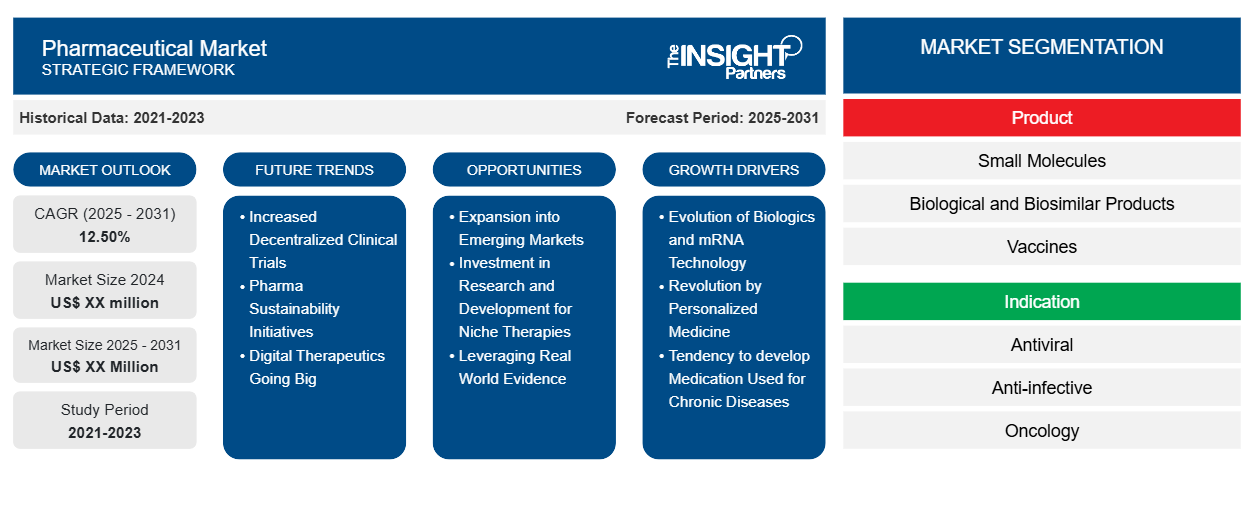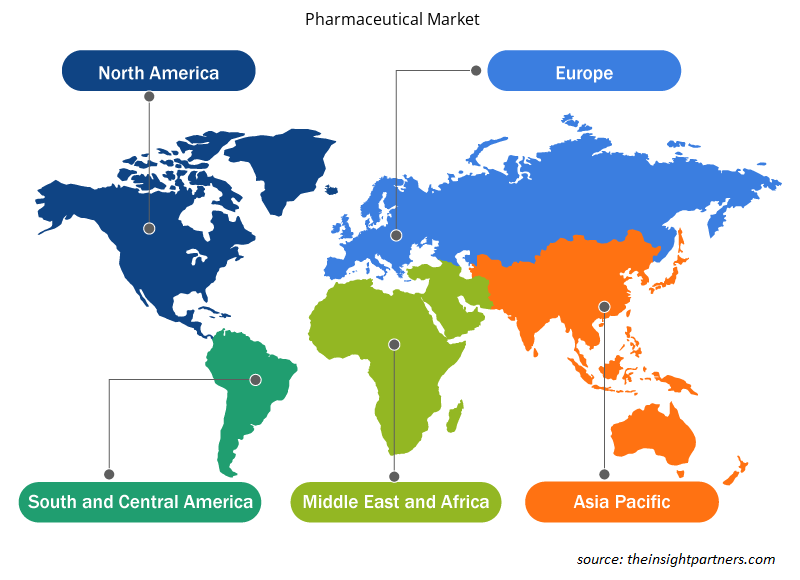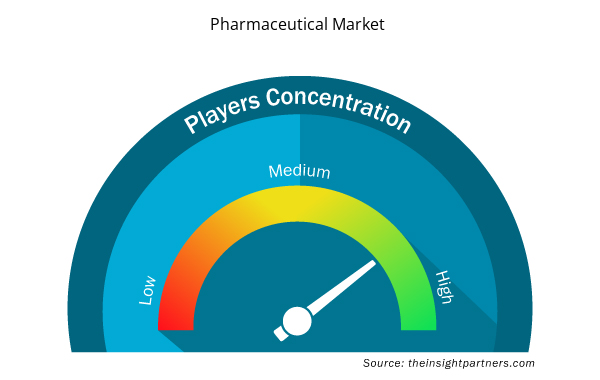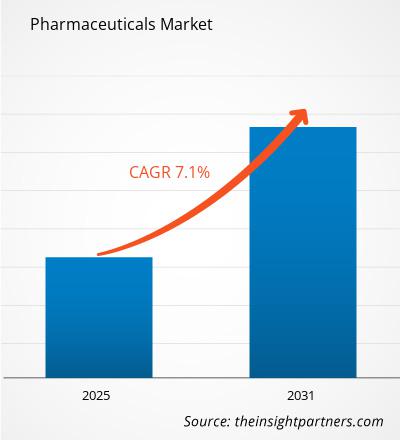预计到2031年,医药市场规模将从2024年的1.75778万亿美元增至2.8403万亿美元。预计2025年至2031年期间,该市场的复合年增长率将达到7.1%。供应链的多元化和跨地区监管的演变可能会在未来几年带来新的市场趋势。
医药市场分析
市场增长主要源于全球疾病负担的增加、创新疗法的涌现以及药物可及性的扩大。此外,生物制剂和个性化医疗的进步正在改变治疗方案,提高疗效并改善患者预后。市场涵盖各种产品,包括处方药和非处方药,凸显了其在医疗保健和疾病管理中的重要作用。此外,制药行业对微生物检测的需求也在不断增长,因为它对于确保产品安全和合规性至关重要,尤其是在药物开发和生产过程中。
医药市场概况
制药行业每年以6%的速度稳步增长,这主要是由于患有慢性和严重疾病的人数不断增加。糖尿病、 肥胖症、癌症和阿尔茨海默病等疾病的全球负担持续以惊人的速度增长,这进一步加剧了医疗进步的需求。目前,全球有1.71亿糖尿病患者,预计到2030年这一数字将翻一番。肥胖症影响着14亿人,预计到2030年这一数字将达到33亿。此外,1800万人患有阿尔茨海默病,到2025年,这一数字可能会增加到3500万。
为了应对这些日益严重的疾病,制药公司正在大力投资研发,以创造创新疗法。意大利在制药研发上的投资已达 17 亿欧元(18.3 亿美元),过去五年增长了 35%,高于欧洲 20% 的平均水平。此外,仅意大利的制药公司每年在临床试验上投资就达 7 亿欧元(7574.2 亿美元),如果算上医疗器械公司,这一数字将上升到 10 亿欧元(10.8 亿美元)。公私合作伙伴关系 (PPP) 的作用日益增强,这进一步支持了这一进程,例如美国国立卫生研究院、美国 FDA、10 家制药公司和 5 个非营利组织之间的合作,旨在为 3000 万身患罕见疾病的美国人加速基因疗法的开发。
新冠疫情的影响也显著影响了医药市场的扩张,预计 2020 年至 2027 年期间市场净累计增长将达到 5000 亿美元。虽然所有地区的疫苗接种率都已超过第一波水平,但加强针的使用情况仍然不一致,这给未来疫情的走向带来了不确定性。对创新药物的需求将继续激增,尤其是在肿瘤学领域,预计到 2027 年该领域的支出将达到 3700 亿美元,几乎是目前水平的两倍。此外,到 2027 年,专科药物将占全球支出的 43%,占发达市场总支出的 56%。到 2027 年,包括突破性细胞和基因疗法在内的生物技术药物将占全球支出的 35%,这标志着向先进生物治疗药物的转变。biotherapeutics.
定制此报告以满足您的要求
您可以免费定制任何报告,包括本报告的部分内容、国家级分析、Excel 数据包,以及为初创企业和大学提供优惠和折扣
医药市场:

- 获取此报告的顶级关键市场趋势。此免费样品将包括数据分析,从市场趋势到估计和预测。
医药市场驱动因素和机遇
扩大全球药品获取渠道并发展新兴市场
随着制药行业的发展,全球药品使用量因药物可及性的改善而大幅增加。由于药品供应增加和治疗方法的采用率提高,以规定日剂量衡量的药品使用量在过去十年中增长了 36%。然而,预计到 2027 年,增长速度将放缓,药品总使用量将达到 3.4 万亿剂,比 2022 年的水平增长 8%。预计拉丁美洲、亚洲和非洲的药品使用量增长最快,这主要归因于人口增长和医疗保健可及性的提高,而北美和欧洲的药品使用量将非常低。药品支出也反映了这些趋势。预计到 2027 年,全球药品市场的复合年增长率 (CAGR) 将达到 3-6%,达到 1.9 万亿美元。增长轨迹因地区而异——发达经济体将保持稳定的增长率,因为新产品可以抵消专利到期造成的损失;而拉丁美洲、东欧和亚洲部分地区将因药品使用量增加和创新药物采用率提高而实现强劲增长。尽管美国新品牌支出将超过过去五年,但在总支出中所占的份额将较小。CAGR) of 3–6% through 2027, reaching US$ 1.9 trillion. The growth trajectory varies by region—developed economies will maintain steady growth rates as new products offset losses from patent expiries, while Latin America, Eastern Europe, and parts of Asia will see robust expansion due to volume increases and higher adoption of innovative medicines. While new brand spending in the US will surpass the last five years, it will constitute a smaller share of total spending.
意大利在制药行业的重要地位进一步体现了制药业向国际市场的转变。2023-2024 年,全球医药市场仍然是医疗保健可及性的基石,尽管出口额比上一年减少了 97 亿美元,但总出口额仍达 8348 亿美元。随着对基本药物的需求不断增长,成熟市场和新兴市场在全球供应链中都发挥着关键作用。德国以 1198.5 亿美元(占出口总额的 14.4%)的医药出口额领先,美国(274 亿美元,占比 22.9%)是其最大目的地,展示了其在高质量药品制造方面的主导地位。瑞士紧随其后,出口额为 990.8 亿美元(11.9%),主要出口到美国(307.2 亿美元,占比 31%),巩固了其在创新疗法方面的优势。美国位居第三,出口额达903.0亿美元(10.8%),是中国(98.9亿美元,11%)的主要供应国,凸显了全球贸易格局的变化。比利时(825.2亿美元,9.9%)和爱尔兰(715.6亿美元,8.6%)仍然是主要供应国,尽管两国的出口额分别下降了20%和5%,这凸显了制定具有韧性的市场战略的必要性。
除了成熟经济体外,新兴市场正日益影响着全球医药贸易。意大利的出口额达到503.2亿美元(6%),同比增长6%,其中美国(84.3亿美元,16.8%)为其主要买家。法国(380.1亿美元,4.6%)、荷兰(341.9亿美元,4.1%)和英国(274.9亿美元,3.3%)继续扩张,其中荷兰的出口额显著增长了20%,这主要得益于德国(62.4亿美元,18.3%)的需求。与此同时,西班牙(218.6亿美元,2.6%)尽管出口额下降了22%,但仍然是比利时的重要供应国。
随着新兴经济体制药能力的增强,投资、技术转让和监管协调的机会开始加速涌现。不断变化的形势凸显了制定可持续的可及性战略的必要性,以确保发达市场和发展中市场都能有效满足日益增长的医疗保健需求。
美国《通胀削减法案》(IRA)也将影响药品定价和费用分摊。然而,由于缺乏实施基准,具体影响仍不确定。随着全球需求持续增长,到2027年,癌症治疗支出将达到3700亿美元,而神经病学支出也将因罕见神经系统疾病、阿尔茨海默病和偏头痛等新疗法的出现而上升。预计到2027年,免疫学支出增速将放缓至3-6%,受生物仿制药竞争降价的推动,免疫学支出年均增长率将达到12%。
总体而言,受区域增长趋势、药品可及性的提高、公私合作的扩大以及专科和生物技术治疗的持续创新的影响,药品支出和需求将继续上升。
通过创新、人工智能和扩张创造增长机会
强大的制造能力、市场拓展潜力、技术进步、经济贡献以及人工智能驱动的创新推动着医药市场在多个维度上呈现巨大机遇。印度是全球第三大医药生产国,按产量计算,按价值计算,位列第十四,已成为全球医药供应的关键参与者。该国占全球疫苗产量的 60%,满足了世界卫生组织 40% 至 70% 的疫苗需求,是全球医疗安全的重要贡献者。这种主导地位为扩大生产设施、增加出口和建立国际伙伴关系以加强全球市场份额创造了机会。同时,作为第三大医药市场的日本为旨在扩展业务的制药公司提供了有利可图的机会。其结构化的贸易体系和监管环境创造了稳定且知识驱动的进入途径,使公司能够在全球最先进的医疗市场之一站稳脚跟。
除了地域扩张之外,制药行业正经历一场技术革命,基因治疗、预防医学和数字健康技术取得了显著进步。这些创新为生物技术公司、人工智能驱动的药物研发和个性化医疗打开了大门,预计将改变患者护理、疾病预防和治疗方法。该行业的经济意义也十分显著,因为全球制药行业支撑着7430万个就业岗位,其中相关行业间接就业4510万个,其他衍生行业就业2370万个。这凸显了在人才培养、劳动力扩张和供应链优化方面的投资机会,从而进一步推动经济增长。
此外,人工智能正在重塑医药制造和研发领域,提高效率并节省成本。人工智能驱动的解决方案可以降低10%至30%的人工成本,提高10%至35%的机器和流程效率,改善20%至40%的维护/服务运营,并优化20%至40%的物流和路线。此外,人工智能正在彻底改变药物研发,将从药物研发到临床前候选阶段的时间缩短高达50%,从而实现更快、更高效的药物开发。这为制药公司投资人工智能、自动化和智能工厂提供了一个极具吸引力的机会,从而实现经济高效的高质量药物生产。
在个性化医疗、数字医疗、生物制药和远程药房的推动下,制药行业正在经历一场变革性的转变,为增长和创新创造了巨大的机遇。将药物基因组学整合到治疗计划中,可以实现高度针对性的药物治疗,减少不良反应并改善患者预后。这为基因检测服务、生物信息学和精准药物开发带来了投资机会。包括电子健康记录 (EHR)、远程药房和移动医疗应用程序在内的数字医疗技术的快速普及,为医疗科技解决方案、人工智能驱动的药物管理和远程医疗平台带来了一个利润丰厚的市场。
生物制药和基因疗法正在重塑癌症、自身免疫性疾病和遗传性疾病的治疗模式,推动对先进药物生产、冷链物流和专业药房服务的需求。随着药剂师在药物治疗管理 (MTM)、免疫接种项目和慢性病管理中的临床作用不断扩大,对培训项目、人工智能驱动的决策支持工具和协作护理模式的需求也日益增长。远程药房和远程医疗的兴起进一步弥合了医疗保健方面的差距,尤其是在医疗资源匮乏的地区,为虚拟药房平台和自动化处方管理解决方案开辟了道路。
此外,药物警戒和药物安全正成为关键的关注领域,这促使人们投资于人工智能驱动的药物监测系统、上市后监测和合规解决方案。随着药剂师参与健康倡导,预防性医疗保健服务、生活方式指导和整体医学整合领域也涌现出新的机遇。最后,制药创业蓬勃发展,利基配药药房、个性化药物配方和特种药物生产推动着商业创新。
随着这些趋势的加速,投资者、医疗保健提供商和技术创新者有机会利用快速发展的医药生态系统,确保全球范围内加强药品的获取、改善患者的治疗效果并持续实现行业增长。
医药市场报告细分分析
有助于得出医药市场分析的关键部分是分子类型、适应症、产品、类型、分销渠道和地理位置。
- 根据分子类型,医药市场可细分为小分子产品、生物制品及生物仿制药。2024年,小分子在医药市场中占据较大份额,预计在2024年至2031年期间将实现显著的复合年增长率。
- 根据适应症,市场可分为代谢疾病、癌症、免疫学、呼吸系统疾病、心血管疾病、神经系统疾病、罕见疾病及其他。2024年,癌症领域占据了医药市场的最大份额。
- 根据产品类型,药品市场分为品牌药和仿制药。2024年,品牌药在药品市场中占据较大份额,预计在2024年至2031年期间将实现显著的复合年增长率。
- 从类型上看,药品市场分为处方药和非处方药。2024年,处方药在药品市场中占据较大份额,预计在2024年至2031年期间将实现显著的复合年增长率。
- 按分销渠道划分,医药市场分为医院药房、零售药房和在线药房。2024年,医院药房占据了医药市场的最大份额,预计在2024年至2031年期间将实现显著的复合年增长率。
医药市场份额地域分析
医药市场报告的地理范围主要分为五大区域:北美、欧洲、亚太地区、中东和非洲以及南美和中美。受慢性病、癌症和传染病日益流行的推动,美国医药市场正在经历显著增长。根据美国癌症协会的数据,2022 年,美国新增癌症病例超过 190 万例,导致约 61 万人死亡。2024 年,美国将有 200 万人被诊断出患有癌症。随着癌症病例的增加,对创新治疗方案的需求也日益增长。治疗性疫苗旨在刺激免疫系统靶向癌细胞,为传统疗法提供了有希望的替代方案。Provenge (sipuleucel-T) 于 2010 年获得 FDA 批准,是首个获得批准的治疗性癌症疫苗。它专为前列腺癌设计,突显了免疫疗法在延长患者寿命方面的潜力。案件数量的增加推动了研发投资,并鼓励了公司和学术机构之间的合作。
根据美国癌症统计数据乳腺癌统计,2021 年,全美女性乳腺癌发病率约为 27 万。美国国家乳腺癌基金会的数据显示,约 10% 至 15% 的乳腺癌病例为三阴性乳腺癌 (TNBC)。2024 年 11 月发表的一项题为“新抗原 DNA 疫苗安全可行,可在三阴性乳腺癌患者中诱导新抗原特异性免疫反应”的研究是第一项已完成的仅针对 TNBC 患者的新抗原疫苗研究。研究结果证实了新抗原疫苗治疗在所研究患者群体中的可行性和潜力。此外,18 名患者中有 16 名在接种疫苗三年后仍无癌,这有效地训练了他们的免疫系统以消灭任何残留的癌细胞。
正如美国癌症研究协会于2024年4月在《健康日新闻》上所报道,胰腺癌是一种高度致命的疾病。一种基于mRNA的个体化治疗疫苗——自体基因cevumeran(胰腺癌疫苗),已显示出在某些患者中预防癌症复发的潜力。在免疫系统对疫苗产生反应后,八名患者中有六名三年内没有患上胰腺癌。这种基于mRNA的疫苗利用患者肿瘤中存在的20种独特蛋白质来训练免疫系统识别和攻击癌细胞。目前,一项临床试验正在进行中,旨在评估自体基因cevumeran疫苗联合化疗和免疫疗法药物(阿特珠单抗)与标准化疗的疗效对比。该试验由自体基因cevumeran的开发商基因泰克(Genentech)和BioNTech部分资助。
此外,不断增长的生物制药市场也可能有利于市场增长。在美国的各行各业中,生物制药行业以研究和创新为特色,并因此脱颖而出。根据美国药品研究与制造商协会的报告《美国生物制药行业的经济影响》,2022 年美国生物制药行业的直接产出超过 8000 亿美元。如果考虑到供应商和其他部门的影响,总经济贡献将增长到超过 1.65 万亿美元,占美国经济总量的 3.6%。2022 年,生物制药行业在国内研发上的投资估计为 1410 亿美元,占美国所有行业资助的医疗卫生研发的 78.6%。同一份报告提到,2022 年,美国生物制药行业在全国拥有 1574 家工厂,按照现行的良好生产规范生产 FDA 批准的人用产品。
2024年,美国政府最终确定了《2022年通货膨胀削减法案》(IRA)中首批十种药品的价格,标志着一个重要的里程碑。经过数月与制药商的谈判,Eliquis、Stelara和Jardiance等药品的价格已下调38%至79%。预计到2026年,这些价格调整将为纳税人节省60亿美元,并为患者节省15亿美元。
医药市场区域洞察
Insight Partners 的分析师已详尽阐述了预测期内影响医药市场的区域趋势和因素。本节还讨论了北美、欧洲、亚太地区、中东和非洲以及南美和中美洲的医药市场细分和地域分布。

- 获取医药市场的区域特定数据
医药市场报告范围
| 报告属性 | 细节 |
|---|---|
| 2024年的市场规模 | 17577.8亿美元 |
| 2031年的市场规模 | 28403亿美元 |
| 全球复合年增长率(2025-2031) | 7.1% |
| 史料 | 2021-2023 |
| 预测期 | 2025-2031 |
| 涵盖的领域 | 按分子类型
|
| 覆盖地区和国家 | 北美
|
| 市场领导者和主要公司简介 |
|
医药市场参与者密度:了解其对商业动态的影响
医药市场正在快速增长,这得益于终端用户需求的不断增长,而这些需求又源于消费者偏好的转变、技术进步以及对产品优势的认知度不断提升等因素。随着需求的增长,企业不断扩展产品线,不断创新以满足消费者需求,并抓住新兴趋势,从而进一步推动市场增长。
市场参与者密度是指特定市场或行业内企业或公司的分布情况。它表明特定市场空间内竞争对手(市场参与者)的数量相对于其规模或总市值而言。
在医药市场运营的主要公司有:
- 强生公司
- 辉瑞公司
- 默克公司
- 礼来公司
- 百时美施贵宝公司
- 埃斯蒂夫
免责声明:以上列出的公司没有按照任何特定顺序排列。

- 获取医药市场顶级关键参与者概述
医药市场新闻和最新发展
医药市场评估通过收集一手和二手研究的定性和定量数据进行,这些数据包括重要的公司出版物、协会数据和数据库。以下列出了市场的一些关键发展:
- 强生公司宣布,美国食品药品监督管理局 (FDA) 授予尼泊卡利单抗(nipocalimab)临床试验快速通道认定 (FTD),用于治疗中度至重度干燥综合征 (SjD) 成年患者。此前,该疗法已于去年年底获得突破性疗法认定 (BTD)。目前,尚无用于治疗该疾病的先进疗法获批。(来源:强生公司,公司网站,2025 年 3 月)
- 辉瑞公司宣布,美国食品药品监督管理局 (FDA) 批准了 ADCETRIS(brentuximab vedotin)联合来那度胺和利妥昔单抗产品的补充生物制剂许可申请 (sBLA)。该疗法适用于已接受两线或两线以上全身治疗的复发或难治性大B细胞淋巴瘤 (LBCL) 成人患者,包括各种类型的弥漫大B细胞淋巴瘤 (DLBCL)。该疗法适用于不适合接受自体造血干细胞移植 (auto-HSCT) 或嵌合抗原受体-T (CAR-T) 细胞疗法的患者。(来源:辉瑞公司,公司网站,2025年2月)
医药市场报告覆盖范围和交付成果
《医药市场规模和预测(2021-2031)》报告对以下领域进行了详细的市场分析:
- 涵盖范围内所有主要细分市场的全球、区域和国家层面的医药市场规模和预测
- 医药市场趋势以及市场动态,例如驱动因素、限制因素和关键机遇
- 详细的 PEST 和 SWOT 分析
- 医药市场分析涵盖主要市场趋势、全球和区域框架、主要参与者、法规和最新市场发展
- 行业格局和竞争分析,涵盖市场集中度、热图分析、知名参与者以及医药市场的最新发展
- 详细的公司简介
- 历史分析(2 年)、基准年、预测(7 年)及复合年增长率
- PEST 和 SWOT 分析
- 市场规模价值/数量 - 全球、区域、国家
- 行业和竞争格局
- Excel 数据集



Report Coverage
Revenue forecast, Company Analysis, Industry landscape, Growth factors, and Trends

Segment Covered
This text is related
to segments covered.

Regional Scope
North America, Europe, Asia Pacific, Middle East & Africa, South & Central America

Country Scope
This text is related
to country scope.
常见问题
The market is expected to register a CAGR of 7.1% during 2024–2031.
Rising global disease burden, increasing demand for innovative treatments, expanding global access to medicines, and growing emerging markets are significant factors fueling the market growth.
North America dominated the market in 2024.
The market value is expected to reach US$ 2,840.30 billion by 2031.
Johnson & Johnson, Pfizer Inc, Merck & Co Inc, Eli Lilly and Co, Bristol-Myers Squibb Co, ESTEVE, UCB SA, Teva Pharmaceutical Industries Ltd, Hikma Pharmaceuticals Plc, Viatris Inc, AstraZeneca Plc, Sanofi SA, GSK Plc, F. Hoffmann-La Roche Ltd, Novartis AG, and AbbVie Inc are among the key players in the market.
Regional power shifts, supply chain diversification, and regulatory evolution are expected to trend in the market in the coming years.
Trends and growth analysis reports related to Life Sciences : READ MORE..
The List of Companies - Pharmaceuticals Market
- Johnson & Johnson
- Pfizer Inc
- Merck & Co Inc
- Eli Lilly and Co
- Bristol-Myers Squibb Co
- ESTEVE
- UCB SA
- Teva Pharmaceutical Industries Ltd
- Hikma Pharmaceuticals Plc
- Viatris Inc
- AstraZeneca Plc
- Sanofi SA
- GSK Pic
- F. Hoffmann-La Roche Ltd
- Novartis AG
- AbbVie Inc
The Insight Partners performs research in 4 major stages: Data Collection & Secondary Research, Primary Research, Data Analysis and Data Triangulation & Final Review.
- Data Collection and Secondary Research:
As a market research and consulting firm operating from a decade, we have published and advised several client across the globe. First step for any study will start with an assessment of currently available data and insights from existing reports. Further, historical and current market information is collected from Investor Presentations, Annual Reports, SEC Filings, etc., and other information related to company’s performance and market positioning are gathered from Paid Databases (Factiva, Hoovers, and Reuters) and various other publications available in public domain.
Several associations trade associates, technical forums, institutes, societies and organization are accessed to gain technical as well as market related insights through their publications such as research papers, blogs and press releases related to the studies are referred to get cues about the market. Further, white papers, journals, magazines, and other news articles published in last 3 years are scrutinized and analyzed to understand the current market trends.
- Primary Research:
The primarily interview analysis comprise of data obtained from industry participants interview and answers to survey questions gathered by in-house primary team.
For primary research, interviews are conducted with industry experts/CEOs/Marketing Managers/VPs/Subject Matter Experts from both demand and supply side to get a 360-degree view of the market. The primary team conducts several interviews based on the complexity of the markets to understand the various market trends and dynamics which makes research more credible and precise.
A typical research interview fulfils the following functions:
- Provides first-hand information on the market size, market trends, growth trends, competitive landscape, and outlook
- Validates and strengthens in-house secondary research findings
- Develops the analysis team’s expertise and market understanding
Primary research involves email interactions and telephone interviews for each market, category, segment, and sub-segment across geographies. The participants who typically take part in such a process include, but are not limited to:
- Industry participants: VPs, business development managers, market intelligence managers and national sales managers
- Outside experts: Valuation experts, research analysts and key opinion leaders specializing in the electronics and semiconductor industry.
Below is the breakup of our primary respondents by company, designation, and region:

Once we receive the confirmation from primary research sources or primary respondents, we finalize the base year market estimation and forecast the data as per the macroeconomic and microeconomic factors assessed during data collection.
- Data Analysis:
Once data is validated through both secondary as well as primary respondents, we finalize the market estimations by hypothesis formulation and factor analysis at regional and country level.
- Macro-Economic Factor Analysis:
We analyse macroeconomic indicators such the gross domestic product (GDP), increase in the demand for goods and services across industries, technological advancement, regional economic growth, governmental policies, the influence of COVID-19, PEST analysis, and other aspects. This analysis aids in setting benchmarks for various nations/regions and approximating market splits. Additionally, the general trend of the aforementioned components aid in determining the market's development possibilities.
- Country Level Data:
Various factors that are especially aligned to the country are taken into account to determine the market size for a certain area and country, including the presence of vendors, such as headquarters and offices, the country's GDP, demand patterns, and industry growth. To comprehend the market dynamics for the nation, a number of growth variables, inhibitors, application areas, and current market trends are researched. The aforementioned elements aid in determining the country's overall market's growth potential.
- Company Profile:
The “Table of Contents” is formulated by listing and analyzing more than 25 - 30 companies operating in the market ecosystem across geographies. However, we profile only 10 companies as a standard practice in our syndicate reports. These 10 companies comprise leading, emerging, and regional players. Nonetheless, our analysis is not restricted to the 10 listed companies, we also analyze other companies present in the market to develop a holistic view and understand the prevailing trends. The “Company Profiles” section in the report covers key facts, business description, products & services, financial information, SWOT analysis, and key developments. The financial information presented is extracted from the annual reports and official documents of the publicly listed companies. Upon collecting the information for the sections of respective companies, we verify them via various primary sources and then compile the data in respective company profiles. The company level information helps us in deriving the base number as well as in forecasting the market size.
- Developing Base Number:
Aggregation of sales statistics (2020-2022) and macro-economic factor, and other secondary and primary research insights are utilized to arrive at base number and related market shares for 2022. The data gaps are identified in this step and relevant market data is analyzed, collected from paid primary interviews or databases. On finalizing the base year market size, forecasts are developed on the basis of macro-economic, industry and market growth factors and company level analysis.
- Data Triangulation and Final Review:
The market findings and base year market size calculations are validated from supply as well as demand side. Demand side validations are based on macro-economic factor analysis and benchmarks for respective regions and countries. In case of supply side validations, revenues of major companies are estimated (in case not available) based on industry benchmark, approximate number of employees, product portfolio, and primary interviews revenues are gathered. Further revenue from target product/service segment is assessed to avoid overshooting of market statistics. In case of heavy deviations between supply and demand side values, all thes steps are repeated to achieve synchronization.
We follow an iterative model, wherein we share our research findings with Subject Matter Experts (SME’s) and Key Opinion Leaders (KOLs) until consensus view of the market is not formulated – this model negates any drastic deviation in the opinions of experts. Only validated and universally acceptable research findings are quoted in our reports.
We have important check points that we use to validate our research findings – which we call – data triangulation, where we validate the information, we generate from secondary sources with primary interviews and then we re-validate with our internal data bases and Subject matter experts. This comprehensive model enables us to deliver high quality, reliable data in shortest possible time.

 获取此报告的免费样本
获取此报告的免费样本